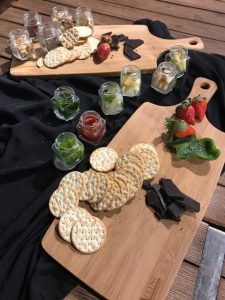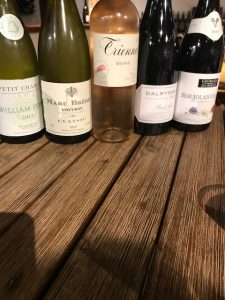Developing Your Palate
I love trying and tasting new wines; developing the palate with different grape varieties and styles is always worth exploring. And tasting wines from Italy, France and Australia is the perfect way to spend a rainy day! I think we all enjoyed the tasting!
Prosecco Borgo Molino (Treviso Italy): We started the evening off with a Prosecco. This family owned winery is based in Treviso (in the Veneto region) in Italy where the soil is calcareous clay. Sergio Nardin runs the business with his two sons Paolo and Pietro. I like the refreshing apple notes to this wine coupled with the acidity and structure. Starting an evening with a Prosecco, what more could you want?
William Fèvre Petit Chablis 2015: Next we had a Chablis from producer William Fèvre. Although William Fèvre’s family has lived in the area for more than 250 years, it was in 1959 that he produced the first vintage with 7 hectares of vineyards. Fast forward to today and they are one of the biggest land owners in Chablis with 51 hectares of vineyards ( 15.9 are classified as Premiers Crus and 15.2 as Grand Crus). In Chablis, there is the famous Kimmeridgian soil interspersed with marl and marly limestone which gives the wines that famous minerality and freshness. If you have the chance to go to the village of Chablis, go and stay at Hostellerie des Clos in the centre then a 100 metres is the cellar door for William Fèvre where you can taste through the latest vintage. There are four appellations in Chablis; Petit Chablis (18% of Chablis wines)* is an appellation at 230m-280m dotted around the village of Chablis. Other appellations are; Chablis (64% of Chablis wines), Chablis Premier Cru (16% of Chablis wines), Chablis Grand Cru (2% of Chablis wines) *SOURCE: http://www.chablis-wines.com, figures from 2016.
Marc Brédif Vouvray Classic 2015: I don’t tend to find many Chenin Blancs in Australia so I thought it would be interesting to show this wine. This Chenin Blanc is from the Loire Valley in France where the soils are a mixture of clay, limestone, siliceous, sand soils across the different vineyards. The domain also makes red and rosé wines in Chinon which is further inland and to the south of the Loire river. The domaine was first called Chateau les Roches when it was set up in 1893 and renamed when Marc Brédif took over in 1919.
Triennes Rosé 2016: There is so much fantastic rosé out there it can be difficult to know where to start! We headed to southern France for this one made mainly from Cinsault but with additions of Grenache, Syrah and Merlot. Grapes were picked at night time when it was cooler and only pressed for a few hours to ensure the right amount of colour and flavour was imparted to the wine. I like the history of this winery; two friends from Burgundy and one from Paris found the Domaine du Logis de Nans in the Var, east of Aix en Provence in 1989. They renamed it ‘Triennes’ referring to Triennia, the festival for Bacchus, which was held every three years during Roman times and the “Tri” represents the three original partners. With its southern aspect, cool microclimate with clay and limestone soils, they now produce a range of wines, I’d love to visit one day!
Georges Duboeuf Beaujolais-Villages 2015: I really enjoy Gamay, I find it a very approachable grape variety and love trying the different wines from Beaujolais. I tasted this Georges Duboeuf blind and was taken aback by its freshness and structure.Georges Duboeuf is now synonymous to Beaujolais but the Duboeuf family used to make wine further north, in the Mâconnais region, over 400 years ago. Fast forward to 1964 and Georges Duboeuf set up Les Vins Georges Duboeuf and since the 1980s has been shipped around the world. This wine is made from the Gamay grape, which actually was found in northern Burgundy back in the 14th century before it was banned. Here in Beaujolais there are two types of soil; granite in the north where the 10 Crus are found (Brouilly, Régnié, Chiroubles, Côte de Brouilly, Fleurie, Saint-Amour, Chénas, Juliénas, Morgon, Moulin-à-Vent) and clay in the south, where it is more flat.
Another domain I tried…quite a while ago was from Julien Sunier, a Morgon. If you have the chance, I would try a range of Gamays and see which ones you enjoy!
Dalrymple Pinot Noir from Tasmania 2015: Established by Bertel and Anne Sundstrup in 1987, Dalrymple is located in the Pipers River region of northeast Tasmania with apparently has amazing views of the Bass Strait, I will need to visit to see for myself! The winery wants the individual sites and single vineyards to reflect their soil and location. This wine is made from fruit taken from Coal River and from the east coast near the Tamar Valley. Peter Caldwell is the winemaker who studied at Roseworthy Agricultural College in South Australia followed by working in France (Burgundy, Bordeaux) as well as New Zealand and California. I was interested to read that Pinot Noir has always been Peter’s passion, he explains; “ the most difficult grape to grow, the most difficult wine to make well. The most satisfying of victories.”


